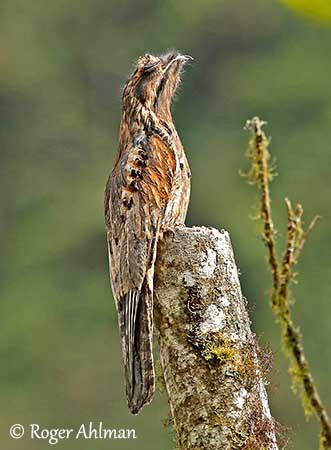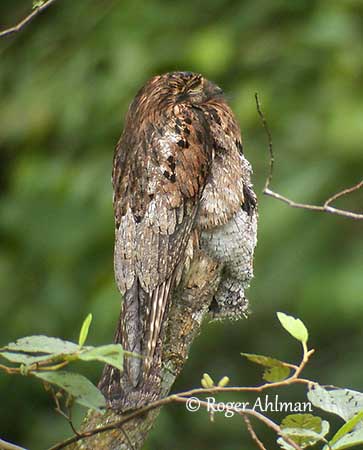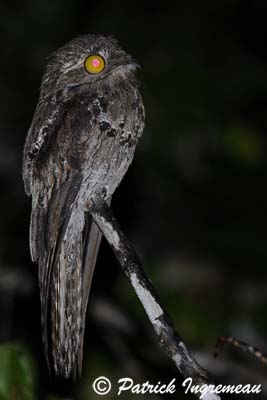
Common Potoo
Nyctibius griseus
Caprimulgiforme Order - Nyctibiidae Family
BIOMETRICS :
Length : 36-41 cm ; Wingspan: 85-95 cm ; Weight: 160-190 g
DESCRIPTION:
Common Potoo is a nocturnal bird with cryptic plumage.
The adult male has pale greyish brown to dark brown plumage, finely vermiculated overall with black, buff, cinnamon and grey. Its mottled and streaked pattern makes it almost invisible when perched on dead tree. Flight feathers are barred with pale colour.
Underparts are paler, grey-brown to pale greyish-buff, with fine dark streaks. Breast shows sometimes several black rounded spots as loose broken collar across the chest. Throat is paler. The tail shows several blackish bands, up to 8 to 10.
On the head, crown and nape are densely streaked with blackish and brown. We can see black gape line, characteristic of these birds. It has some stiff rictal bristles around the bill.
Hooked bill is blackish. Mouth is very wide, adapted for its hunting manner. Eyes are yellow, turning orange at night. Legs and feet are grey.

Both sexes are similar.
Juvenile is paler than adults, and has pale grey plumage patterned with darker grey, brown and black.
VOICE: SOUNDS BY XENO-CANTO
Common Potoo utters melancholic sounds “BO-OU, BO-ou, bo-ou, bo-ou, bo-ou, bo-ou, bo-ou, bo-ou », up to 8 lamenting phrases, starting loudly, then lower in pitch little by little, and decreasing in volume.
Often heard on moonlight nights, this haunting call is attributed to a sloth by rural people.
HABITAT:
Common Potoo breeds in open woodlands and savannahs. It can be seen in forest edges and semi-open areas with hedges and scattered trees. It avoids montane regions, and it is rarely seen over 1900 metres of elevation.
RANGE:
Common Potoo breeds and is resident in tropical Central and South America, from Costa Rica to northern Argentina and northern Uruguay.
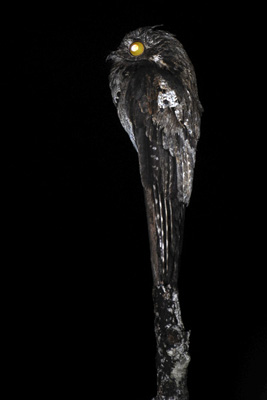
BEHAVIOUR:
Common Potoo is a nocturnal insectivore. It starts to hunt just after dusk, perched on exposed branch. It makes frequent sallies for taking large flying insects with its large mouth broadly opened. It can perch as fairly low or in canopy.
By night, its eyes reflect the light, turning orange. When perched, it gives its haunting song “BO-OU, BO-ou, bo-ou…”
During the day, Common Potoo rests in trees. It usually perches on dead snags in tree, perfectly motionless, at various heights. Its cryptic plumage and its upright posture make it almost invisible, as a dead small branch. It can stay completely still during long moments.
Common Potoo defends nest and chick by some displays such as: remaining motionless, the most typical display of this species; elaborated slow movements in order to conceal the chick; and by vocal distraction display at night. But Common Potoo adopts different strategies, according to the circumstances.
When the bird stays motionless in characteristic safe posture, while it slowly raises the head, it almost closes the eyes, leaving only a fine aperture sometimes opened.
FLIGHT:
Common Potoo has strong flight and it performs deep wing beats.
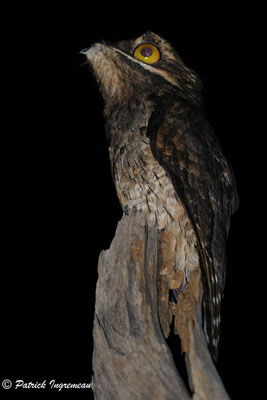
REPRODUCTION:
Common Potoo female lays its egg at top of dead trunk, in a shallow depression without nest-material added. If disturbed, the adult adopts the characteristic posture, with raised head and bill, outstretched neck and compressed plumage, similar to the dead wood where it is perched. After 15 minutes without disturbed, it gradually relaxes to less rigid posture.
Female lays one white egg, with lilac markings. Incubation lasts about 33 days, shared by both adults. Chick is covered in white down, with black markings, dark bill and eye line.
Nestling grows rapidly and adopts the same parental posture, perched upright against the adult, at the top of the dead trunk.
Chick is fed by regurgitation for the first days, and it fledges about 47 to 50 days after hatching. Both parents feed the chick.
Fr: Ibijau gris
All : Urutau-Tagschläfer
Esp : Nictibio Urutaú
Ital : Nittibio comune
Nd : Grijze Reuzennachtzwaluw
Russe : Серый исполинский козодой
Photographers:
Roger Ahlman
Pbase Galleries Peru and Ecuador
Patrick Ingremeau
TAMANDUA
Philippe et Aline Wolfer
GALERIE
Text by Nicole Bouglouan
Sources :
HANDBOOK OF THE BIRDS OF THE WORL Vol. 5 by Josep del Hoyo-Andrew Elliott-Jordi sargatal - Lynx Edicions - ISBN : 8487334253
NIGHTJARS - A Guide to Nightjars and Related Nightbirds – Nigel Cleere and Dave Nurney - Yale University Press - First Edition (August 11, 1998) - ISBN 10: 0300074573 / ISBN 13: 9780300074574
A GUIDE TO THE BIRDS OF COLOMBIA by Steven L. Hilty and William L. Brown
Princeton University Press – ISBN 069108372X
Arthur Grosset's Birds (Arthur Grosset)
SORA Searchable Ornithological Research Archive (Blair O. Wolf)
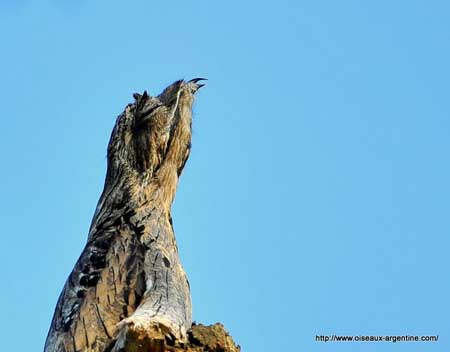
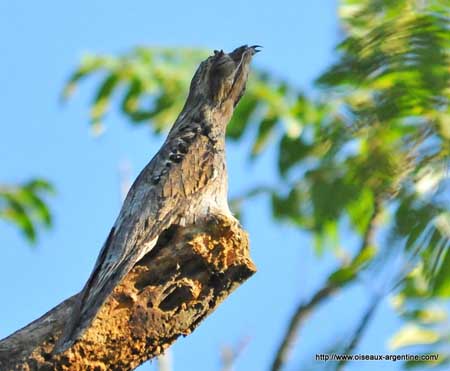
DIET:
Common Potoo feeds mainly on large nocturnal flying insects, which hawks with its wide opened mouth.
